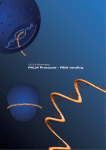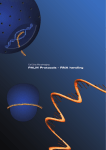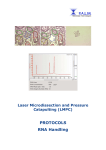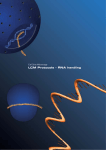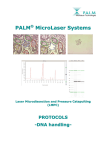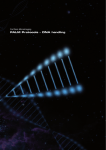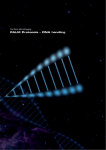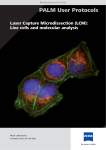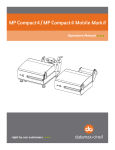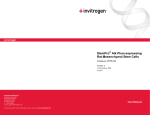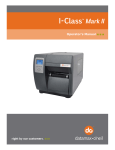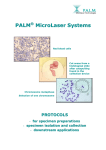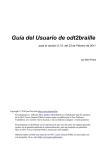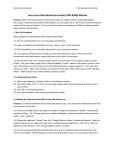Download PALM Protocols – RNA handling
Transcript
PALM Protocols - RNA Handling Carl Zeiss MicroImaging PALM Protocols – RNA handling 1 PALM Protocols RNA handling Non contact Laser Capture Microdissection Carl Zeiss MicroImaging – Location Munich – Germany Content 5 6 7 7 7 9 9 9 10 10 10 11 11 12 12 12 12 13 14 14 14 14 15 15 16 16 16 17 17 17 17 18 18 20 21 22 22 23 24 25 Introduction - Some remarks on RNA The DOs and DON’Ts on handling RNA Preparation of slides Samples on MembraneSlide Samples on glass slides Treatment to remove RNases UV treatment Poly-L-Lysine treatment Mounting samples onto slides Frozen sections Paraffin embedded (FFPE) sections Cytospins Blood and tissue smear Staining procedures Paraffin embedded (FFPE) sections Frozen sections Cresyl Violet Hematoxylin/Eosin (HE) Non-contact Laser Capture Microdissection (LCM) Procedures Tips to improve morphological information Diffusor CM AdhesiveCap opaque LiquidCover Glass Storage Collection devices AdhesiveCap Other microfuge tubes Collection procedures “Dry” collection (AdhesiveCap) “Wet” collection (other microfuge tubes) Capture check - looking into the cap to see the lifted samples Downstream Applications RNA from frozen sections RNA from FFPE sections Using components of the QIAGEN RNeasy® FFPE Kit Using other extraction methods Quality control of RNA General remarks on RNA (distribution, content, RNase activity) LabTips for working with RNA Other protocols (DNA, Chromosomes, Live Cells) Introduction Some remarks on RNA RNA is a biological macromolecule with many different functions. Messenger RNA (mRNA), transcribed from DNA, serves as a template for synthesis of proteins. This protein synthesis is carried out by ribosomes, which consist of ribosomal RNA (rRNA) and proteins. Amino acids for protein synthesis are delivered to the ribosome on transfer RNA (tRNA) molecules. RNAs are also part of riboproteins and ribozymes. Analysis of RNA can provide a good reflection of an organism’s gene expression profile. Gene expression profiling of material isolated by microdissection has become a very important method for analyzing cellular behavior in a micro scale and is used in research and clinical applications. Therefore the isolation of high quality RNA is crucial for all subsequent steps and the success of the overall experiment. 5 PALM Protocols - RNA Handling The DOs and DON’Ts of handling RNA RNA degradation is a common reason for failing experiments. RNA is prone to digestion by a wide variety of endogenous and exogenous RNases. These RNases are present on almost all objects that come into contact with human skin and are difficult to inactivate. Even minute amounts are sufficient to destroy RNA. Some precautions can make the difference between an intact and degraded RNA prep (see also: www.ambion.com) and therefore between successful and unsuccessful experiments. DOs • • • • • • • • • • • • designate a special area for working with RNA clean benches with special cleaning solutions e.g. RNaseZap (AMBION, #9780) wear gloves and change them frequently use sterile, disposable plasticware glassware should be treated with 0.1% DiEthylPyroCarbonate (DEPC) or oven baked at 180°C for at least 4 hours before use use filtered pipette tips aqueous solutions should be treated with 0.1% DEPC use only RNase-free reagents, tubes and tips for best results use samples that have been snap frozen on dry ice or in liquid nitrogen; all required reagents should be kept on ice store prepared RNA, aliquoted in ethanol or RNA elution buffer at -80°C to avoid condensation of moisture during thawing, the slides should be frozen at -80°C and rethawed in a tightly sealed container (e.g. 50 ml Falcon tube) in general use protocols (e.g. staining) with short incubation times on ice DON’Ts • • • • • 6 don’t breath on samples; some researchers wear masks don’t touch anything with bare hands don’t autoclave pipette tips, as water vapor may contain RNases don’t allow frozen tissue to thaw don’t resuspend RNA in DEPC water; residual DEPC can inhibit downstream reactions PALM Protocols - RNA Handling Preparation of slides – Samples on MembraneSlide MembraneSlides are special slides covered with a membrane on one side. This membrane is easily cut together with the sample and acts as a stabilizing backbone during lifting. Therefore even large areas are lifted by a single laser impulse without affecting the morphological integrity. Use of MembraneSlide is especially important for isolating single cells, chromosomes as well as live cells or small organisms. Carl Zeiss MicroImaging (CZMI) offers slides (1 mm, 0.17 mm) covered with polyethylene naphthalate (PEN)-membrane. This PENmembrane is highly absorptive in the UV-A range, which facilitates laser cutting. The membrane can be used for all kind of applications. When working with low magnifying objectives like 5x or 10x both regular 1 mm thick glass slides and 0.17 mm glass slides can be used. To keep this flexibility for higher magnifications (20x, 40x or 63x) CZMI recommends using long distance objectives. With those you have the possibility to adapt the working distance to the different glass slides by moving the correction collar on the objective. Regular glass slide (1 mm thick) => 1, thin slide (0.17 mm thick) => dot, DuplexDish and FrameSlide => between dot and 0. Due to the short working distance of the 100x magnifying objectives only 0.17 mm thin cover glass slides can be used. MembraneSlide NF (nuclease free) is certified to be free of DNase, RNase and human DNA. In addition to PEN-MembraneSlide, CZMI also offers polyethylene teraphthalate (PET)membrane covered slides. These slides are helpful for special processes, i.e. for isolation of chromosomes and some fluorescence applications. Alternatively the PET-membrane can be attached to a metal frame (FrameSlide PET). In fluorescence applications (FISH) even weak signals can be detected due to low signal to noise ratio. The frame structure of FrameSlide PET enables immunohistological staining with minimal volume (< 1 ml) and is resistant to microwave treatment. The special bonding is inert and adapted to heat treatment (up to 95°C) so that the membrane does not ruffle during the heating process. If you need information about these slides, please contact: E-Mail: [email protected] 7 MembraneSlide 1.0 PEN MembraneSlide 1.0 PEN NF MembraneSlide 0.17 PEN MembraneSlide 50x1.0 PEN MembraneSlide 1.0 PET FrameSlide PET - Order No. 415101-4401-000 (white) - Order No. 415101-4401-600 (white) - Order No. 415101-4401-500 (uncolored) - Order No. 415101-4401-005 (doublewidth) - Order No. 415101-4401-050 (blue) - Order No. 415101-4401-055 (metal) PALM Protocols - RNA Handling Preparation of slides – Samples on glass slides With PALM MicroBeam almost every kind of biological material can be microdissected and lifted directly from glass slides. Even archival pathological sections can be used after removing the cover slip and the mounting medium. To facilitate easy lifting additional adhesive substances or “Superfrost + charged slides” should only be applied when absolutely necessary for the attachment of poorly adhering special material (e.g. some brain sections or blood vessel rings). In those cases higher laser energy is needed for lifting. Treatment to remove RNases Treatments of MembraneSlides and glass slides to remove RNases are identical. Slides are shipped without any pretreatment. • To ensure RNase-free MembraneSlides (1mm) or glass slides, heat slides at 180°C for 4 hours to completely inactivate RNases. • An alternative to decontaminate slides is treatment with RNase ZAP (AMBION, #9780). First dip the slides for a few seconds into pure RNase ZAP, followed by two separate washings in RNase-free distilled water and drying at 37°C for 30 minutes up to 2 hours. • MembraneSlide NF (nuclease free) is certified to be free of DNase, RNase and human DNA. Treatments to remove nucleases are therefore not necessary using these slides. Note: The thin (0.17 mm) MembraneSlides are not resistant against heat. Use other treatments to remove RNases. UV treatment To overcome the hydrophobic nature of the membrane it is advisable to irradiate with UV light at 254 nm for 30 minutes (e.g. in a cell culture hood). The membrane gets more hydrophilic, therefore the sections (paraffin- and cryosections) adhere better. Positive side effects are sterilization and destruction of potentially contaminating nucleic acids. Poly-L-Lysine treatment Additional coating of the slide with PolyL-Lysine (0.1% w/v, e.g. SIGMA, #P8920) only will be necessary for poorly adhering materials (e.g. brain sections) and should be performed after UV treatment. Distribute a drop of the solution on top of the slide. Let air-dry at room temperature for 2-3 minutes. Avoid any leakage of the membrane, as this might result in impairment of Laser Capture Microdissection. 9 PALM Protocols - RNA Handling Mounting samples onto slides Frozen sections Sectioning Sections are mounted onto MembraneSlides the same way as routinely done using glass slides. To allow subsequent cutting and lifting a coverslip and standard mounting medium must not be applied. Freezing media like OCT or similar may be used but should be kept to a minimum and have to be removed before laser cutting. For optimal RNA protection take a precooled slide and touch the back-side of the slide with your finger (gloves!) to warm only the region for placing the section. Now transfer section from the knife by touching with the warmed area and dry at -20°C in the cryostat for 2-3 minutes. Fixation CZMI recommends the dehydration in ice-cold 70% ethanol for 2-3 minutes. Removing the tissue freezing medium If OCT or another tissue freezing medium is used, it is important to remove it before Laser Microdissection, because these media will interfere with laser efficiency. Removing the medium is easily done by dipping the slide 5-6 times in ice-cold RNase-free water. If the sections are stained in aqueous solutions, the supporting substance is normally removed “automatically” by the water containing steps. 10 Paraffin embedded (FFPE) sections Sectioning Sections are mounted onto MembraneSlides the same way as routinely done using glass slides. Floating the section on warm water as well as hot plate techniques can be applied. After mounting, let dry the slides overnight in a drying oven at 56°C. To allow laser cutting and lifting a coverslip and standard mounting medium must not be applied. Deparaffination Paraffin will reduce the efficiency of the laser, sometimes completely inhibiting cutting and lifting. If you are working with unstained sections it is therefore very important to remove the paraffin before laser cutting and lifting. If applying standard staining procedures deparaffination is routinely included in any protocol. 1 mm MembraneSlides can be used like normal glass slides. Minimal procedure: 1. Xylene 2 minutes, 2 times 2. Ethanol 100% 1 minute 3. Ethanol 96% 1 minute 4. Ethanol 70% 1 minute Note: The thin (0.17 mm) MembraneSlides are not as resistant against organic solvents and should only be handled according to the Minimal procedure (see above). Especially longer treatment in xylene will resolve the glue holding the membrane to the slide. PALM Protocols - RNA Handling Cytospins Cytospins can be prepared on glass slides or on MembraneSlides. After centrifugation with a cytocentrifuge let the cells air-dry. Then fix for 5 minutes in 100% methanol. Allow the cytospins to dry at room temperature before staining. Blood and tissue smear Distribute a drop of (peripheral) blood or material of a smear over the slide. Be careful to avoid injuries in the membrane, which would lead to leakage during fixation or washing steps and therefore would impair the laser capture microdissection process. Let smears air-dry shortly and fix them for 2 up to 5 minutes in 70% ethanol. 11 PALM Protocols - RNA Handling Staining procedures For isolation of high quality RNA use only freshly prepared and precooled staining solutions and take notice of our tips on handling RNA (please see page 24). Paraffin embedded (FFPE) sections Cresyl Violet After deparaffination continue with the staining procedure of your choice. Most standard staining procedures can be used for FFPE sections (for recommendations see Frozen sections). Frozen sections Most standard histological stainings (e.g., HE, Methyl Green, Cresyl Violet, Nuclear Fast Red) are compatible with subsequent RNA isolation. Note: Using frozen sections endogenous RNases may still be active after the short fixation step. Therefore it is recommeded to keep all incubation steps as short as possible. Please use RNase-free water and solutions for all steps. All required reagents should be kept on ice. At PALM Laboratories we usually perform the Cresyl Violet or Hematoxylin/Eosin (HE) staining. 12 This short staining procedure colors the nuclei violet and the cytoplasm weak violet. It is recommended for RNase-rich tissues since all solutions contain high ethanol concentrations. Procedure 1. after fixation (2 min, 70% Ethanol) dip slide for 30 sec into 1% cresyl violet acetate solution (*) 2. remove excess stain on absorbent surface 3. dip into 70% Ethanol 4. dip into 100 % Ethanol 5. air-dry shortly (1-2 min) (*) Dissolve solid cresyl violet acetate (e.g. ALDRICH #86,098-0) at a concentration of 1% (w/v) in 50% EtOH at room temperature with agitation/ stirring for several hours to overnight. Filter the staining solution before use to remove unsolubilized powder. (Sometimes Lot to Lot variations in the purchased cresyl violet powder can lead to weaker staining results if the dye content is below 75%). PALM Protocols - RNA Handling Hematoxylin/Eosin (HE) Note: In most cases this cresyl violet staining procedure will be sufficient for cell identification. If an enhancement of the staining is desired, a reinforcement by two additional steps in 50 % ethanol (first before the staining in cresyl violet; second after the staining in cresyl violet) is possible. Additional intensification can be obtained by increasing the working temperature of all solutions to room temperature. The endogenous RNase acitivity varies between different tissues (please see page 23). Therefore, when the short staining protocol is modified by additional steps (50 % ethanol) or by increasing the working temperature CZMI strongly recommends a quality control of the RNA (please see page 22). Ambion offers the LCM Staining Kit (#1935) which also contains a cresyl violet dye. When using this kit we recommend to omit the final xylene-step of the Ambion instruction manual because xylene makes the tissue very brittle and reduces the adhesion of the section to the PEN-membrane. HE-staining is used routinely in most histological laboratories and does not interfere with good RNA preparation if intrinsic RNase activity is low. The nuclei are stained blue, the cytoplasm pink/red. Procedure 1. after fixation quickly dip slide 5-6 times in RNase-free distilled water 2. stain 1-2 minutes in Mayer’s Hematoxylin solution (e.g. SIGMA, #MHS-32) 3. rinse 1 minute in DEPC-treated tap water or blueing solution 4. stain 10 seconds in Eosin Y (e.g. SIGMA, #HT110-2-32) 5. perform a quick increasing ethanol series (70%, 96%, 100%) 6. air-dry shortly Storage Stained slides can be used immediately or stored at -80°C before LCM. To avoid excess condensation of moisture during thawing, the slides should be frozen in a tightly sealed container (e.g. two slides back to back in a 50 ml Falcon-tube). For rethawing the container should not be opened before it is completely warmed up again to ambient temperature. 13 PALM Protocols - RNA Handling Non-contact Laser Capture Microdissection (LCM) Procedures Please, additionally have a look into the PALM MicroBeam user manual. Tips to improve morphological information For LCM embedding and glass covering of the specimen is inapplicable. Thus, the rough open surface of the section/material often results in impaired view of morphology. Diffusor CM Diffusor CM can be inserted into PALM CapMover like any holder and is moved over the sample. The opaque glass diffuses the incident microscope light, which smoothens the harshness of contrast and, depending on material and staining, even minute details as nuclei and cell boundaries show up. Even slight differences in color become visible. For more details and handling, please see Diffusor CM product information. Holders for PALM RoboMover and PALM CapMover II are equipped with diffusors. PALM CombiSystem 14 Diffusor CM - Order No. 415101-2100-320 PALM Protocols - RNA Handling AdhesiveCap opaque The white/opaque filling of AdhesiveCap clearly improves visualization of morphological information of the samples at the object plane due to enhanced color balance and contrast, which makes the view comparable to those of coverslipped tissue sections. Two different microfuge tube sizes with these filled caps are available from CZMI. LiquidCover Glass The polymeric and low viscose Liquid-Cover Glass completely embeds the tissue and smoothens the rough tissue surface, resulting in enhanced morphology. For more details and handling, please see LiquidCover Glass product information. For more details and handling, please see AdhesiveCap product information. AdhesiveCap opaque - Order No. 415101-4400-250 (500 μl) AdhesiveCap opaque - Order No. 415101-4400-240 (200 μl) LiquidCover Glass - Order No. 415101-4400-600 15 PALM Protocols - RNA Handling Collection devices AdhesiveCap The intention of AdhesiveCap is to allow LCM (Laser Capture Microdissection) without applying any capturing liquid into the caps prior to LCM. This minimizes RNase activity. Beside the quick relocation of the lifted samples in the cap due to instant immobilization there is no danger of evaporation and crystal formation during extended specimen harvesting. For more details and handling, please see also AdhesiveCap product information. Note: CZMI recommends AdhesiveCap as a collection device for all RNA experiments. Other microfuge tubes Other commercially available RNase-free plasticware can be used, too. (e.g. ABgene #AB-0350; 0.5 ml tubes) If there are no RNase-free tubes available use the following procedure to remove RNases from regular tubes. Treatment of microfuge tubes to remove RNases add 0.1 ml DEPC to 100 ml of double distilled water to get a 0.1% DEPC solution (DEPC: e.g. ROTH #K028.1) 1. stir for 5-6 h at room temperature to dissolve the DEPC 2. soak the reaction tubes into the DEPC solution, take care that the tubes are completely covered with liquid (not blistered!) and incubate overnight at room temperature 3. autoclave the tubes together with the solution for 20 minutes at 121°C to inactivate the DEPC 4. discard the liquid carefully and thoroughly. Dry the tubes at 50°C-80°C 5. use the tubes as usual Note: DEPC is toxic and should be used under a hood! AdhesiveCap opaque - Order No. 415101-4400-250 (500 μl) AdhesiveCap opaque - Order No. 415101-4400-240 (200 μl) AdhesiveCap clear - Order No. 415101-4400-255 (500 μl) AdhesiveCap clear - Order No. 415101-4400-245 (200 μl) 16 „Dry collection“ procedure Collection procedures Please have a look into the PALM MicroBeam user manual. „Dry“ collection (AdhesiveCap) Note: CZMI recommends AdhesiveCap as collection device for all RNA experiments. Capturing without liquid minimizes RNase activity. After LCM add a lysis buffer of your own choice (e.g. QIAGEN: 350 μl RLT buffer) and incubate „upside down“ for 30 minutes. Subsequently centrifuge the lysate and then apply the routine RNA extraction procedure. “Wet” collection (other microfuge tubes) Pipette 20 μl lysis buffer into the cap. The lifted cells or cell areas will stick onto the wet inner surface of the cap and will not fall down after the lifting procedure. Be aware that aqueous solutions will dry out after a while. When using glass mounted samples it may be advisory to put more liquid (up to 40 μl) into the cap. Capture check – looking into the cap to see the lifted samples To control the efficiency of lifting it is possible to have a look into the collection device (e.g. microfuge cap) with the 5x, 10x, 20x, 40x and 63x objectives. By using the software function “go to checkpoint” the slide is moved out of the light path and the cap can be lowered further towards the objectives for looking inside. 17 PALM Protocols - RNA Handling Downstream Applications RNA from frozen sections For RNA extraction a procedure of choice can be used. To capture microdissected samples from frozen sections we recommend AdhesiveCap. The RNeasy® Micro Kit (QIAGEN, #74004) combined with AdhesiveCap (500 μl) in our hands results in very good yield and quality of RNA. (For recommended modifications to the original QIAGEN protocol please see page 19) The final RNA solution (12 μl) may be stored at -20°C or used directly for reverse transcription. Quality control by direct analysis like the Agilent Bioanalyzer (RNA 6000 Pico LabChip® Kit) is limited to concentrations above 50 pg/μl and may only be possible with large microdissected samples (some 2 mm2 of collected areas from tissue sections of 5-10 μm thickness). We normally use 5 to 10 μl of the final RNA solution as template in a RT-reaction of 20 μl (e.g., Transcriptor First Strand cDNA Synthesis Kit, ROCHE, # 04 379 012 001). 18 PALM Protocols - RNA Handling Applying the components of the QIAGEN RNeasy® Micro Kit: 1. Add 350 μl Buffer RLT containing ß-Mercaptoethanol to the tube with the LCM elements in the AdhesiveCap, then vortex and incubate in an “upside down” position for 30 min. Thorough lysis is essential for good RNA yield. Note: 2. ß-Mercaptoethanol (ß-ME) must be added to Buffer RLT before use. Add 10 μl ß-ME per 1 ml Buffer RLT. Dispense in a fume hood and wear appropriate protective clothing. Buffer RLT is stable at room temperature for 1 month after addition of ß-ME. Spin down the lysate in a microcentrifuge for 5 minutes. (13400 rcf; e.g. Eppendorf 5415D: 12000 rpm) Note: Samples can now be stored for later use at -80°C or extracted immediately following the original protocol of the QIAGEN RNeasy® Micro Kit (Handbook 04/2003). 3. To continue with the isolation transfer the lysate to a RNase-free 1.5 ml microcentrifuge tube. 4. Now switch to step 5 of the QIAGEN protocol “Total RNA Isolation from Microdissected Cryosections” (RNeasy® Micro Handbook 04/2003, pp 20). 5. “Add 1 volume (350 μl) of 70% ethanol to the homogenized lysate, and mix well by pipetting. Do not centrifuge. Continue immediately with step 6.” Note: All further steps (6-14) of the QIAGEN protocol remain unchanged and should be performed step by step as listed there. Please consider also the comments and tips of the QIAGEN RNeasy® manual, especially the section: “Things to do before starting” 19 PALM Protocols - RNA Handling Downstream Applications RNA from FFPE sections For collecting microdissected samples we recommend AdhesiveCap. PALM Laboratories prefer the QIAGEN RNeasy® FFPE Kit (#74404) with some specific modifications. This procedure is very effective and allows a high final concentration of RNA due to a small elution volume. Genomic DNA contamination is minimized by a special DNA removal column (gDNA Eliminator spin column). Since normally only stained tissue sections are used for microdissection the deparaffination and staining is done according to standard procedures for slides (please see pages 10, 12 and 13). Furthermore, the incubation with Proteinase K in PALM protocols is prolonged significantly compared to the QIAGEN RNeasy® FFPE protocol, because all our tests with laser microdissected material from various tissues showed higher RNA yields applying longer digestion times. Note: For formalin fixed samples a Proteinase K digestion step is essential. The time necessary for optimal Proteinase K digestion depends on many factors like tissue type, fixation procedure or element size of lifted material. An overnight digestion (12-18 hours) is a good starting point for optimization but shorter digestion times may be tested as well. To our experience at least 3 hours digestion should be applied with any extraction procedure and material. The RNA solution may be stored at -20°C or used directly for reverse transcription. Quality control by direct analyses like the Agilent Bioanalyzer is very limited and only possible with large microdissected samples (some 4 mm2 from tissue sections of 5-10 μm thickness). We normally use 5 to 10 μl of the final RNA solution in a RT-reaction of 20 μl (e.g., Transcriptor First Strand cDNA Synthesis Kit, ROCHE, # 04 379 012 001) using random-oligomers (instead of oligoT) as primers for the cDNA synthesis. Note: The use of random or gene-specific primers is important. Reverse transcription of formalin fixed RNA with standard oligoTprimers is inefficient and strongly 3-prime biased due to the numerous strand breaks and modifications inflicted by the formalin fixation and paraffin embedding procedure. 20 PALM Protocols - RNA Handling Using components of the QIAGEN RNeasy® FFPE Kit1. Add 150 μl Buffer PKD and 10 μl of Proteinase K to the tube, containing the LCM elements in the AdhesiveCap, and vortex in an “upside down” position. 2. Use an incubator to digest the samples in an “upside down” position at 55°C overnight (or for at least 3 hours), then vortex and heat at 80°C for 15 min in a heating block. 3. Add 320 μl of Buffer RBC to adjust binding conditions. 4. Mix the lysate thoroughly and transfer it to a gDNA Eliminator spin column placed in a 2 ml collection tube. Centrifuge for 30 sec at ≥8000 x g (e.g. Eppendorf 5415D: ≥10000 rpm). Discard the column and save the flow-through. 5. Add 720 μl of 100% ethanol to the flow-through and mix well by pipetting. Do not centrifuge. Proceed immediately to the next step. 6. Transfer 700 μl of the sample to a RNeasy MinElute spin column placed in a 2 ml collection tube. Close the lid gently and centrifuge for 15 sec at ≥8000 x g (≥10000 rpm). Discard the flow-through. Reuse the collection tube in step 7. 7. Repeat step 6 until the entire sample has passed through the RNeasy MinElute spin column. Reuse the collection tube in step 8. 8. Add 500 μl Buffer RPE to the RNeasy MinElute spin column. Close the lid gently and centrifuge for 15 sec at ≥8000 x g (≥10000 rpm) to wash the spin column membrane. Discard the flow-through. Reuse the collection tube in step 9. Note: Buffer RPE is supplied as a concentrate. Ensure that ethanol is added to Buffer RPE before use. 9. Add 500 μl Buffer RPE to the RNeasy MinElute spin column. Close the lid gently and centrifuge for 15 sec at ≥8000 x g (≥10000 rpm) to wash the spin column. After centrifugation carefully remove the spin column from the collection tube so that the column does not contact the flow-through. 10. Place the RNeasy MinElute spin column in a new 2 ml collection tube, and discard the old collection tube with the flow-through. Open the lid of the spin column and centrifuge at full speed for 5 min. Discard the collection tube with the flow-through. It is important to dry the spin column membrane, since residual ethanol may interfere with downstream reactions. 11. Place the RNeasy MinElute spin column in a new 1.5 ml collection tube. Add 14-30 μl RNase-free water directly to the spin column membrane. Close the lid gently and centrifuge for 1 min at full speed to elute the RNA. The dead volume of the RNeasy MinElute spin column is 2 μl: elution with 14 μl of RNase-free water results in a 12 μl eluate. 12. The RNA solution may be stored at -20°C or used directly for reverse transcription. Note: Quality control by direct analysis like the Agilent Bioanalyzer (Pico chip) is very limited and may only be possible with quite large microdissected samples (often some 4 mm2 collected area from tissue sections of 5-10 μm thickness). 21 PALM Protocols - RNA Handling Downstream Applications Using other extraction methods Apart from the QIAGEN Kit there are many other possibilities and kits to extract RNA from FFPE-material. Depending on the material and the experience of the user even simple procedures like homemade AGTC-methods or Trizol can be quite efficient. If the original extraction protocol does not contain any Proteinase K digestion step we recommend to apply a simple procedure as listed below. The most common method used for assessing the integrity of total RNA is to analyze the RNA sample on an agarose gel. In general, at least 200 ng of RNA must be loaded onto the gel. Procedure To analyze RNA samples with concentrations down to 50 pg/μl, the Agilent 2100 Bioanalyzer is an alternative to traditional gel-based analysis and provides information about RNA quality (degradation, purity) and quantity (see also: www.chem.agilent.com). 1. Add 20 μl digestion buffer containing Proteinase K (150 mM NaCl, 100 mM Tris pH 7.5, 0.5% Igepal, 0.5 μg/μl Proteinase K) to the tube containing the LCM elements in the AdhesiveCap. A prognosis of the expected amount of RNA in a tissue is difficult since many factors like species, cell/tissue-type, fixation, staining, fragmentation, extraction procedure and others will influence the outcome. 2. Use an incubator to digest the samples in an “upside down” position at 55°C overnight. 3. Spin down the lysate in a microcentrifuge. (13400 rcf; e.g. Eppendorf 5415D: 12000 rpm) 4. Inactivate Proteinase K by heating to 90°C for 10 minutes. 5. Add the appropriate lysis buffer and mix by intense vortexing; if not proceeding immediately, store the digested samples at -20°C or -80°C. 6. Continue with your preferred extraction procedure. Note: Proteinase K digestion time should be optimized for any tissue sample (at least 3 hours are recommended, but up to 18 hours may be more efficient). 22 Quality control of RNA PALM Protocols - RNA Handling General remarks on RNA (distribution, content, RNase activity) A typical mammalian cell contains 10-30 pg total RNA (mRNA, rRNA, tRNA). The majority of RNA molecules are tRNAs and rRNAs. mRNA represents only 1-5% of the total cellular RNA. Approximately 360 000 mRNA molecules are present in a single cell, corresponding to approximately 12 000 different transcripts with a typical length of 2 kb. Some mRNAs comprise as much as 3% of the mRNA pool whereas others account for less then 0.01% (QIAGEN, Bench guide). RNA distribution in a typical mammalian cell Total RNA per cell Total RNA in nucleus DNA : RNA in nucleus mRNA molecules Typical mRNA size ~ 10-30 pg 80-85% 15-20% 1-5% ~ 14% ~ 2:1 5 2x10 - 1x106 1900 nt rRNA (28S, 18S, 5S) tRNAs, snRNAs, low MW species mRNAs per cell RNA content in various cells and tissues Cell cultures (107 cells) Mouse tissue (100 mg) Quantitative hierarchy of RNase activity in mouse tissues (AMBION, Inc.) Mouse tissues Pancreas Spleen Lung Liver Thymus Kidney Heart Brain Fold increase relative to brain 181,000 10,600 5,300 64 16 8 2 1 NIH/3T3 HeLa COS7 Brain Heart Intestine Kidney Liver Lung Spleen Total RNA (μg) 120 150 350 120 120 150 350 400 130 350 mRNA (μg) 3 3 5 5 6 2 9 14 6 7 Also the RNase activities vary dramatically across different tissues (Krosting J, Latham G, AMBION, Inc.). A comparison of total RNase activities for 8 different mouse tissues showed that total RNase activity spans a 181,000-fold range from pancreas to brain, which points out the importance of RNase control. 23 PALM Protocols - RNA Handling PALM LabTips for working with RNA For best RNA quality we use frozen sections on MembraneSlides. Frozen sections should not be stored for more than a few days at -80°C. Freezing should be performed after staining and drying in an air tight container. A prognosis of the expected amount of RNA is difficult since many factors will influence the outcome (see above). From mouse liver frozen sections we usually are able to retrieve 5-20 pg RNA per cell (calculated from extractions of 1000 cells and analysis with an Agilent Bioanalyzer; Agilent Application Note 5988-EN on our website or at www.chem.agilent.com). Note: Quantitative results from an analysis with the RNA Pico kit are dependent on the salt content of the sample. Archival tissues are mostly formalin-fixed and paraffin-embedded. RNA extraction from these tissues is not very effective because of the cross linking properties of aldehydes. Other methodologies for preservation of high molecular weight RNA in FFPE tissue are described by: Vincek et al. 2005 (Diagn Mol Pathol, 14,3: 127-133) and Olert et al. 2001 (Pathol Res Pract, 197: 823-826) For more information see our website: www.palm-microlaser.com/publications Summarized recommendations: • Keep attention to DOs and DON´Ts on handling RNA (page 6) • Take AdhesiveCap as collection device for all RNA experiments (page 16) • Choose a short staining procedure for tissues with high content of endogenous RNases (e.g. Cresyl Violet) (page 12) • RNeasy® Micro Kit (QIAGEN, #74004) results in good RNA yield (quality and quantity) from frozen sections in our lab (page 18) • RNeasy® FFPE Kit (QIAGEN, #74404) results in good RNA yield (quality and quantity) from FFPE tissue in our lab (page 20) 24 PALM Protocols - RNA Handling Other brochures and protocols Live cells Chromosomes DNA Microdissection from Carl Zeiss Microdissection from Carl Zeiss PALM MicroBeam PALM User Protocols Laser Micromanipulation in Life Sciences Chromosome Preparation ® PALM® MicroLaser Systems L ap pu ullttiin ng g La asse err M Miiccrro od diisssse eccttiio on na an nd dP Prre essssu urre eC Ca atta ((L LM MP PC C)) Contact-free manipulation of live cells PALM Laboratories A unique service of Carl Zeiss PROTOCOLS -DNA handling- For questions, comments or protocol requests please contact: PALM Laboratories Email: Service Line: [email protected] +49 (0) 89 90 9000-900 25 PALM Protocols - RNA Handling Carl Zeiss MicroImaging GmbH Location Munich Phone: +49 (0) 89 90 9000-900 Fax: +49 (0) 89 90 9000-920 E-Mail: [email protected] 26 August 2008 PALM Protocol – RNA handling www.zeiss.de/microdissection


























